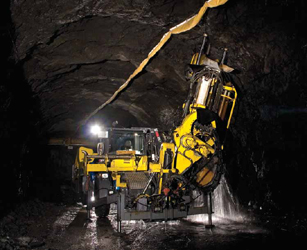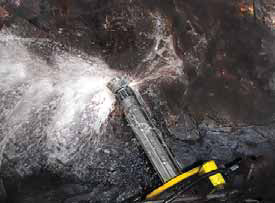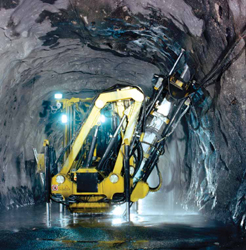
The Simba S7, the latest in the Simba line, is designed to meet the accuracy, productivity and safety needs of
narrow vein miners, Epiroc reports. (Photo: Epiroc)
Underground Drilling Advances
Improve Productivity, Safety While
Cutting Costs
Field-proven technologies increase penetration rates and hole accuracy, thus overall
improving fragmentation
By Jesse Morton, Technical Writer

In 2016, Atlas Copco, also now known as Epiroc, released the Simba S7, a hydraulic long hole drill rig with remote-control capabilities for narrow vein miners. The company described it as a “versatile rig” that enables “increased automation” and is “built for small spaces and tough drilling conditions.”
Versatile and increased automation refers to a half-dozen capabilities that make the rig more accurate, easier to operate and safer. For example, the solution features front- and rear-mounted stingers and a “sturdy” hydraulic boom for stability, a rollover protection- and falling object protection-optimized cabin for increased operator comfort and safety, and the company’s field proven Rig Control System (RCS) for automation.
RCS includes ABC Regular, Drill Plan Handling and Void Detection. “Safety precautions like automatic drill stoppage prevent accidents involving both personnel and equipment,” the company reported. “Add-on automation, including teleremote control, greatly improve the operator’s work environment.”

The brains of the machine feature architecture that enables varying degrees of automation, depending on the miner’s needs. A more basic setup features data monitoring, leveraging the company’s telematics solution, Certiq, which “gathers, compares and communicates equipment information,” the company reported. Sjövall said the solution “gives the customers the possibility to see production numbers, utilization service intervals and more from a central web-based database.” Separately, software solution Underground manager enables plans created in IREDES format to be uploaded to the rig via Rig Remote Access (RRA) or universal serial bus.
The next level is remote control solutions, such as drill stop protection, total station navigation, full teleremote control, and multimachine remote control, which allows for remote management of up to six Simbas.
The next step Epiroc describes as optimization. “Optimization enables you to push your equipment to its full potential, while ensuring that it is not wearing out or breaking down.” Offerings include a rod handling system that automatically adds drill rods, void detection that modulates drilling as needed, breakthrough automatic stop, automatic parallel holding that positions the rig optimally, and advanced boom control for automated drilling.
The rod handling system will “drill and trip out in auto,” Sjövall said. “It holds 11 rods in either 6-ft, 5-ft, 4-ft or 3-ft lengths.” Breakthrough automatic stop “will protect from loss of consumables if drilling into open ground, for example the next drift,” Sjövall said. “This will prevent the rock drill from empty stroke that can damage the rock drill.” And that will increase the lifetime of the drill, he said.
Advanced boom control taps setup data, preset positioning parameters and angles of drilling unit, and helps when positioning is “tricky and time consuming,” Sjövall said. “With a simple press of a button, the drill unit will position according to preset angles,” he said. “Boom positioning between holes are done manually by the operator.”

The MUX offers “better control when drilling in broken ground,” Sjövall said. “It is easier to break rods when tripping out of the hole, especially during downward drilling.”
The rig offers numerous benefits, the company reported. These include high maneuverability, increased productivity, safer working conditions, and optimization of operations by allowing drilling through shift changes and breaks, the company reported.
Selling points include a “safe and dust free operator environment” with a “low noise level and no hydraulics inside the cab,” Sjövall said. The cab also features “ergonomic display positioning and multicontrol joysticks,” he said. The solution provides “safe drilling in dangerous areas with teleremote control,” Sjövall said. “Automatic drill stop increases safety around the rig.” Additionally, modular parts and interfaces “increase flexibility and reduce startup time,” he said. “Digitalization increases precision in planning, drilling and monitoring.”
RRA and Certiq require a standard WiFi system with coverage throughout the mine, Sjövall said. The needed data network infrastructure would also include an IP address, subnet mask or default gateway for each machine; and the same for the control room. It is “possible to communicate via UDP on port 500 and 4500 between the rigs and control room,” he said. “The Access Point needs to have ethernet access to the control room.
Network bandwidth capacity should be between five and 10 megabits per second (Mb/s) per rig. For six remote machines, “the control room would have a minimum of 30 Mb/s of constant streaming data,” Sjövall said. Higher capacity lowers communications latency, he said. “In LKAB, we had a round-trip time below 1 milisecond (ms) from rig to control room,” he said. “From Stockholm to Örebro, we had below 10 ms round trip time.”

The company offers several levels of service agreements to meet the customer’s requirements, Epiroc reported. Most center on proactive planned maintenance to minimize downtime. The company also offers detailed parts information for the full inventory of components, accessories and tools. Epiroc, currently comprised of Atlas Copco’s mining and rock excavation technique business area, is set to split from the parent company in mid-2018.
Water-powered Drill Saves
Wattage
By using strictly Wassara’s water-powered
drills instead of air-powered down-the-hole
(DTH) drills in its underground iron ore
mines, LKAB saves roughly $800,000 per
year. The miner expects to save 821,577 megawatt-hours (MWh), amounting to almost
$25 million, over the next 30 years,
Wassara, an LKAB subsidiary, reported.
And those numbers don’t speak to the numerous other benefits of using water- powered drills, such as improved blasting and increased productivity, said David Petersson, marketing director. Both result from the accuracy of the drilling. The company reported its drills offer “an average borehole deviation of less than 1%,” which bests “other technologies used for production drilling that average a 5%- 20% deviation.” A Wassara water-powered drill, such as the Wassara W100, with a 115-millimeter (mm) bit on an Atlas Copco Simba rig, drilling at a length of up to 56 meters (m), creates “straighter blast holes than any other production drilling method,” Wassara reported. “Accuracy is the most crucial factor for profitability since it indicates the bore hole length and the scale of operation,” Petersson said. “A high accuracy will lower the amount of dilution as well as improve ore recovery, fragmentation and overall productivity.”
The drill was originally engineered more than two decades ago for use by the LKAB in Kiruna and Malmberget, currently the two largest underground iron ore mines. At the time LKAB was seeking a solution that allowed them to mine “deeper, bigger and narrower, and at the same time, protect the environment and reduce overall costs.” The main goal was to extend borehole lengths from 28 m to 56 m.

The resulting Wassara drill and hammer technology delivers high-pressure water at a high frequency and energy- per-blow rate. When the water leaves the hammer, it evacuates the cutting and debris, thus cleaning the hole.
The primary challenge was extending the service life of the components, meaning being “able to have the hammers in operation for an acceptable period of time in combination with a good rate of penetration,” Petersson said. It was found that because the water clears the hole, there is lower wear on the hammer, the company reported. “Due to this guide ribs can be used on the outside of the hammer case,” Wassara reported. “These guide ribs will enable a very tight clearance between the hammer and the wall, as close as 1-2 mm.”
Additionally, through use of water pressure, as opposed to air pressure, there is less unwanted damage to the host rock, Wassara reported. “When the water leaves the hammer, the host rock will not get pressurized since there is no change in volume of the water,” the company reported. “If the host rock gets pressurized by, for example, compressed air, then there is a great risk that existing faults get extended.” That could result in an interrupted blast sequence, which would impact the fragmentation.

In the end, LKAB “achieved the upscaling factor they were looking for, meaning with a similar amount of rigs and operators they can get much more out per blast,” Petersson said. Wassara drills were deployed throughout the two mines in 1995. Once drill hole lengths were extended to 56 m, the volume of ore drilled per meter increased by 500% and the required number of sub-levels decreased by 70%, the company reported. “The reason why they stopped at 56 m is that the distance between the top of the holes is getting to be too much, meaning when you blast you get too many large boulders,” he said. “Also, it becomes an issue to charge the hole with explosives when the depth is getting too long.”
Wassara describes its technology as “much more efficient with a higher frequency compared to an air DTH hammer.” The latter delivers a maximum of 2,700 blows per minute (bpm). A Wassara hammer delivers 3,600 bpm. And because the hammer is constantly at the bottom of the hole, the rate of penetration can be as high as a meter per minute with 115-mm drill bits, the company reported. “The 115-mm bit is an optimal size bit for our W100 hammer,” Petersson said. “If you use a large bit on the same size hammer, you will have a slight lower rate of penetration, but with other sizes of hammer and the right size of bit for that hammer model, you will get a similar rate of penetration.”
That efficiency translates to saved wattage. In LKAB’s underground iron ore mines, the drill rigs operate at full pressure daily for 12 hours, with scheduled maintenance stops of eight hours every second week. LKAB reported it drills roughly 1.5 million m per year. “By using the Wassara hammer, LKAB is lowering the energy consumption from the drilling process alone by 27,386 MWh per year.”
